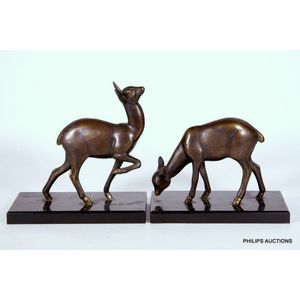Green Patinated Spelter Animalier Group with Rochard Signature
You must be a subscriber, and be logged in to view price and dealer details.
Subscribe Now to view actual auction price for this item
When you subscribe, you have the option of setting the currency in which to display prices to $Au, $US, $NZ or Stg.
- Circa - A Latin term meaning 'about', often used in the antique trade to give an approximate date for the piece, usually considered to be five years on either side of the circa year. Thus, circa 1900 means the piece was made about 1900, probably between 1895 and 1905. The expression is sometimes abbreviated to c.1900.
- Incised - A record of a name, date or inscription, or a decoration scratched into a surface, usually of a glass or ceramic item with a blunt instrument to make a coarse indentation. Compare with engraving where the surface is cut with a sharp instrument such as a metal needle or rotating tool to achieve a fine indentation.
- Spelter - Spelter was the name given to an alloy of zinc and brass or copper used in the 19th century for statuary and lighting. It is a brittle bluish-white metal. It was used as a cheap replacement for bronze, but being brittle easily breaks and can't be repaired. When finished it can often be mistaken for bronze, but if discreet a scratch on the base displays shows a greyish colour, the metal is spelter, if a golden colour the metal is most likely bronze.
- Les Animaliers - Les Animaliers is a term used to describe a movement in French sculpture and decorative arts in the late 19th and early 20th centuries that focused on the depiction of animals. The movement was led by a group of artists known as the Animaliers, who were known for their highly realistic and anatomically accurate sculptures of animals. Many of the Animaliers were trained as taxidermists, and their work was influenced by the naturalist movement, which sought to accurately depict the beauty and diversity of the natural world. The Animaliers were particularly known for their bronze sculptures of animals, which were often cast using the lost-wax process and finished with a patina to give them a naturalistic appearance. The Animaliers' work was popular with collectors and the general public, and it continues to be admired for its attention to detail and technical skill.
This item has been included into following indexes:
Visually similar items

An Art Deco group of two deer on rectangular marble base. 42 cm high

A pair of Art Deco spelter and marble deer bookends, circa 1930s, the pair, one grazing, the other alert, in bronzed colours upon black marble bases with rounded edges, height 20 cm, width 20 cm, depth 10.5 cm

A French group of three deer on oval marble base, signed Lecluc. 38 cm high, 70 cm long

A fine French Art Deco bronze group of two deer signed on the marble base D H Chiparus. 60 cm high, 75 cm wide.
